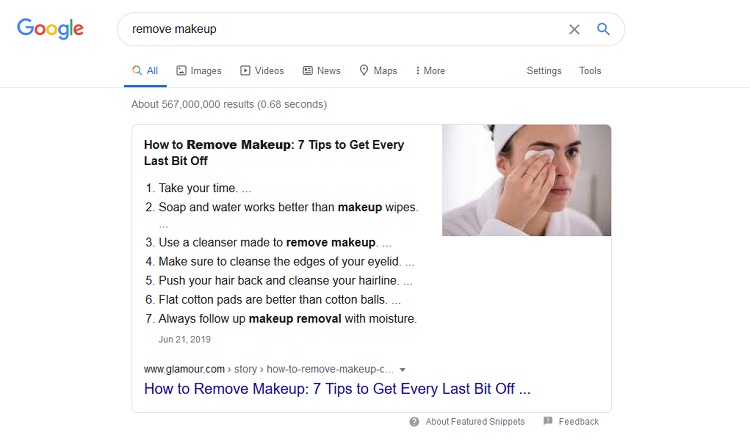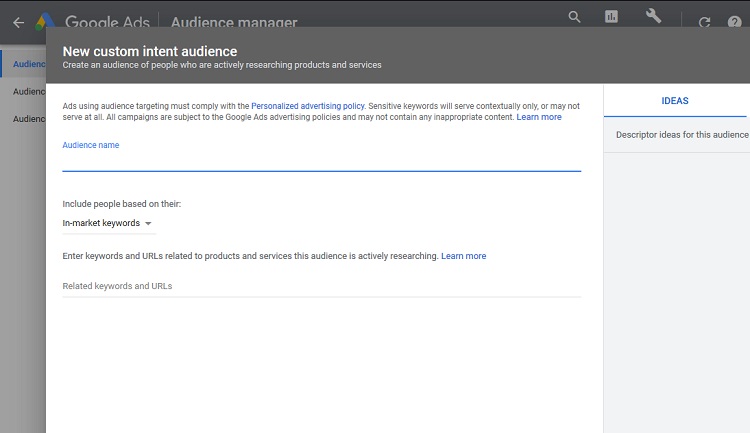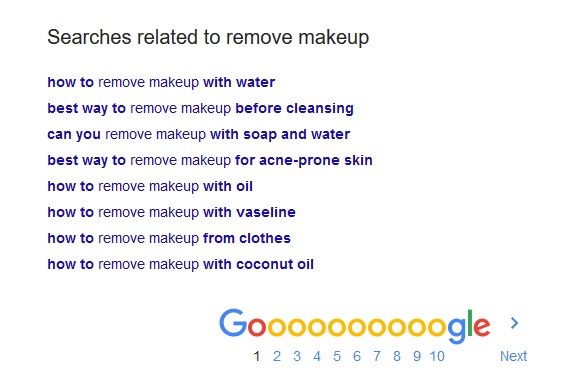Google’s mission “to organize the world’s information and make it universally accessible and useful” gives you an excellent blueprint for how to build your content effectively. If you can produce useful content, Google will make sure it becomes universally accessible.
Let’s take a look at what that means.
Search or User Intent
When you perform a Google search, you have a goal in mind. That goal is your search intent.
In other words, your search term is the what, and the search intent is the why.
Supposed you need to get a haircut.
You might search for “haircut near me.”
The search reveals barbershops and full-service salons in a five-mile radius. After clicking on the first result, you realize that it’s a high-end salon, but you only want a trim.
Going back to your search results, you find that the third result on the list is a simple barbershop with good reviews. Perfect!
If enough people take the same route and end up in the third search result, that teaches Google the query intent behind “haircut near me.”
Soon, the third result on the list will be higher up in the results.
So, what’s the takeaway?
In the broadest sense, you have to find out what the keyword search intent is behind your audience searches.
If Google figures out you’re giving people what they want (i.e., your content is useful), it will bump your content higher in the results.

Browsers vs. Searchers
Before breaking down search intent into categories, it’s useful to understand the difference between users who are in browse mode and those in search mode.
The two overlap in a lot of ways, and a buyer’s journey could lead them from one state to the next and back several times.
It’s important to distinguish these two types of users because each needs to be targeted with a different strategy.
Browsers are those users who aren’t sure of what they want, but they know the general category that they’re interested in. For instance, a browser might go to the library and head for the fiction section to look for a book.
Searchers, on the other hand, know what they’re looking for and either want to narrow down their choices or make an immediate purchase. The same library-goer in a searching state would head straight for the catalog and search for Charlotte Brontë or Jane Eyre.
The same general search terms could respond to both intents.
Someone might search for “Chevy Malibu” to either learn more about the car or because they’re ready to purchase it. So, how do you get your results to the top?
In short, don’t hedge. A man’s reach should exceed his grasp sounds nice on paper, but it fails in practice.
Commit heavily to one type of intent.
Searchers need to be targeted contextually. That is, your user intent SEO should focus on providing information relevant to what your audience is searching for.
Conversely, browsers respond well to behavioral targeting. A broader approach to intent keywords provides a better result.
Ideally, you should target both kinds of searchers. In practice, there’s only so much content you can create.
Four Types of Search Intent
There are roughly four types of search/keyword intent:
- Informational
- Navigational
- Transactional
- Commercial

Informational Keyword Intent – I Want to Know
When you search for information about a topic, you generally want answers to a question.
Now, informational searches can be broad or specific, and different search intent SEO methods serve each of those. But, we’ll get to that later.
Frequent informational searches are how-tos, guides, and white papers.
Sometimes, informational searches are for specific information such as the current weather in your area. However, more often they’re broad in scope, such as an instructional article about changing car tires.
If that sounds like a difficult intent to optimize for, it is. There is often a lot of competition for informational intent searches.
And, they’re more challenging to monetize. People searching for instructions or guides don’t often want to buy something immediately.
But optimizing for informational queries has one major perk — featured snippets.
If Google recognizes your content as the premier source of information for one type of informational search, it gets to be featured on the first page of results.
An answer box highlighting the relevant bits of your content gives you instant authority as the go-to result for specific search intent.
Navigational Keyword Intent – I Want to Visit
Often people know what they are looking for, but they don’t know the exact website. That’s when they use Google as a navigational tool.
For instance, the top search results for the term “time” is the home page of Time Magazine.
Navigational searchers are most often looking for brands or names that they already know.
This type of intent encompasses searches such as:
- [brand name] near me
- [brand name] login
- [brand name] reviews

Transactional Keyword Intent – I Want to Buy
When a searcher is ready to buy, they do a transactional search.
They need something specific, and they just need a place to get it. When there isn’t much differentiation in a product category, searches in that category tend to be transactional.
If you’re in the business of satisfying transactional intent, your pages should rank high for terms like “buy [product name]” and “[product name] deals.”
It’s a straightforward formula of search intent keyword + product/service/brand.
Are you looking to market your services online?
Transactional search intent optimization is your bread and butter.
Users that are ready to buy are a highly-prized commodity. If you have to focus your efforts on a single intent group, this should be it for most SEO efforts.
Here’s an abridged list of buyer intent keywords to use when optimizing for transactional intent:
- Buy
- Deals
- Coupons
- Store
- Price
- Free shipping

Commercial Keyword Intent – I Want to Compare
Lastly, commercial searches are a bit of a grey area.
Some recognize this as a type, while others don’t think it really applies.
The intent behind commercial searches is to learn about a product or category before ultimately deciding on a purchase.
It falls somewhere between informational and transactional.
This category is where top product lists and comparison articles rank the highest.
All of the above is a lot of information about search intent; still, it doesn’t cover why search intent matters for you.

Is Search Intent Really That Powerful?
Search intent is such a dominant ranking factor precisely because it’s not as widely used as others.
Google uses over 200 algorithms to come up with relevant search results. But, even with all that computing power, they still rely on thousands of human evaluators to rate the quality of search results.
The reason they need to do that is, in part, to determine user intent.
So much so that an entire section of Google’s Quality Evaluator Guidelines is dedicated to understanding search intent.
Does that mean you should forget about backlinks, keywords, and other traditional SEO tools?
No way.
Those are still essential factors.
But it does mean that if you don’t consider search intent SEO, you have no real chance of getting to the top.
Searchers today are much savvier than they once were, but that’s a whole different topic. What’s really important is how the traditional path from awareness to purchase has shifted.
People expect much more hand-holding throughout the entire journey, and their search intents reflect that.
Search intent marketing should be taken just as seriously as any other ranking factor.
Just look at this example of how SEO guru, Brian Dean, used search intent optimization to increase his organic traffic sixfold.
OK, so it’s a big deal, got it. But how do you identify your target audience’s search intent? It’s not that difficult; you just need to be methodical.
Identifying Search Intent
Search intent marketing starts with figuring out what your audience wants.
If you want to figure out why someone is searching the way they are, you have to walk a mile in their browsing shoes.
And there’s no better way to do that than to start searching.
Using SERPs to Identify Search Intent
The Search Engine Results Page (or SERP) is a powerful keyword intent tool if you know how to use it.
Google’s search algorithms are continually updating rankings to respond to user’s needs.
Content that ranks great today may not even make it to the first page a month from now.
So, to know what your best approach should be at any given time is to see what Google is paying attention to.
For instance, say you want to create content about makeup removal.
The search query “remove makeup” will be populated mostly with lists of tips for how to remove makeup.
What does that tell you?
For starters, you now know that the search intent for your content is informational. If you try to make content about makeup removal that responds to (say) navigational intent, it probably won’t rank highly.
The other thing you will quickly notice is a relevant keyword:
Tips.
Clearly, searchers in your audience want tips. So, the best way to secure a top spot is to make sure the keyword makes it into your headline.
SERPs help you pinpoint the intent behind a search by showing you exactly which results people are clicking on.
Used correctly, they’re like keyword intent tool for creating the correct content every single time.

Using Search Features to Identify Search Intent
Another powerful tool for identifying the intent behind a search is the features produced by the search.
Search features are any additional content that Google shows you outside of the basic links in the search results.
Love it or hate it, what ends up in the featured search results is what people want to see.
That’s why you see Wikipedia articles featured so often when you search for conceptual information.
For instance, when searching for a term that’s often associated with transactional intent, Google might show you shopping results.
If you search for “movie theater,” Google will likely produce a map of movie theaters in your area.
Search features help you understand what people think when they search for something in three ways.
First, you have an indication of what type of results Google is serving up (shopping results for transactional intent, images for informational searchers, etc.)
Also, where the feature appears on the page gives you an idea of how important it is.
Features don’t always appear at the top of the page.
When they’re lower down in the results, it means the content of the feature is important but not overriding.
And lastly, the content of the feature is a source of valuable insight into buyer intent.
Snippets focus on the most relevant part of the most relevant search result. Think about how much information you can get by mining them.
If videos are served up by Google, take the time to watch them.
If Google thinks a knowledge panel is the best answer to a search query, you’d better be sure to include some key terms from it in your content.
The “People Also Ask” box is a particularly powerful feature, and you can use it to almost single-handedly do intent research in some cases.
It serves to give you a broader understanding of the context around a search.
Google’s suggested searches are an extension of that as well. They show you other topics your audience might be interested in.
Answer The Public is a free tool you can use to compile those suggested searches visually.
Using Ads to Identify Search Intent
What kinds of ads specific search results produce is yet another source of intent.
Google serves up paid ads in the search results, but they work very hard to make sure those ads are relevant to the search.
It all comes back to their mission statement — the information has to be useful.
You can assume that if a search query is producing ads, it’s because those ads are related to what the searcher wants.
There are two points of interest in ads. Their appearance and their content.
The mere fact that ads are showing in SERPs gives you some insight. It means that the searcher’s intent is often transactional.
After all, ads aren’t there to navigate you away or give you tips about makeup.
Next, the content of the ads paints a picture of what searchers most want.
Are the ads trying to sell a product or a service? Are they catering to a local or global market? What emotional triggers are the ads banking on?
The answers to all these questions help you understand where the searcher’s mind went when they performed the search.
Using Searcher Insights to Identify Search Intent
Suppose I hand you a spreadsheet with personal information about someone right before they performed a search.
Once you saw the search terms, could you identify the intent behind it?
Clearly, you’d be able to do that. If you know someone has just come home from work hungry, their intent when searching “pizza” is obviously transactional.
Now, you can’t get that spreadsheet, but you can get more information than you might think, and it’s all useful.
If searches are riddled with “near me” keywords and specific locations, you know that users have local intent.
Moreover, “near me” is an excellent indication that someone is on their mobile device.
People rarely need to find the best restaurant within a few blocks of their home.
That gives you a good indication that you need to optimize your content for mobile users with local intent.
So, as you can see, Google is telling you exactly what people are searching for and how to reach them.
You just need to know how to listen.
Using Google Custom Intent Audiences to Identify Search Intent
Now we’ve gotten to the WMD of intent optimization — Google’s Custom Intent Audiences.
With custom intent audience, Google gives you the ability to only target the people you want with your ad campaigns.
But it also does something else for your SEO search intent efforts.
Here’s how it works:
- Select the “Audience Manager” in the Tools & Settings menu of Google Ads.
- In the Audience Manager, click on “Custom Audiences” and click the “+” button.
- Select “Custom Intent” from the drop-down menu.
- Develop your custom intent audience.
You have several options, starting with naming your audience.

Say you want to define search intent for your audience, and you’re selling drones.
Once you’ve created your audience, you can select from hundreds of in-market search terms that Google provides for you.
Then, you can add keywords and URLs to start populating your audience. In a nutshell, Google is letting you target specifically those people who search for certain URLs.
Now, where would you find a URL that’s useful to target?
How about your most successful competitor? Or, why not the top results on Google when you search for drones?
After entering enough URLs and keywords, you’ll have the perfect audience for your product.
Wait, how does that help with search intent?
Simple, once you start building an audience, Google wants to help you reach them.
To do that, they provide helpful descriptor ideas for your tailored audience.
Those ideas are a gold mine of user intent data. They show you what people in your audience are searching for most in the context of your specific product.
Using custom intent audiences for search optimization this way is an excellent approach, irrespective of whether you end up using the audience for your ads.
It’s hard to think of a better tool to show you precisely what your content needs to include.
What People Want
As you can see, ranking highly on Google is not just about checking off all the keywords and getting X number of backlinks.
There are many other factors involved, and one of the most important is the why behind the search.
If you want to rank highly in 2020 and beyond, the road to the #1 URL is paved with search intentions.


